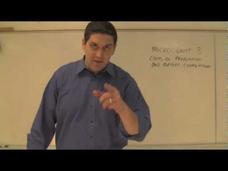Jacob Clifford
Comparative Advantage: Econ Concepts in 60 Seconds
Walk your learners step-by-step through the process of creating a comparative advantage chart with a sample problem involving the production of cars and rice on a production possibilities curve.
Jacob Clifford
Production Possibilities Curve and Opportunity Cost
What happens when the resources used as part of a production possibilities curve are not easily adaptable to produce both goods? Watch as an economics instructor uses an example of an economy producing pizzas and robots in...
Jacob Clifford
Consumer and Producer Surplus
What are the implications when consumers are willing to pay more for something than what they actually end up paying? Similarly, what happens when producers sell for more than they expect? Here is a video where an economics...
Jacob Clifford
Economic Growth
With an increase in investment, what happens to aggregate demand, aggregate supply, and eventually, long-run aggregate supply? Here you'll find a great explanation of how greater long-run aggregate supply correlates to a wide...
Jacob Clifford
Intro - Supply and Demand
Here is the first video of a series on microeconomics in which the presenter summarizes what concepts he intends to cover. Use this to get an idea of the style of instruction, as well as to determine if the concepts covered, such as...
Jacob Clifford
Multiplier and Taxes Practice
How does the math work behind cutting taxes to close a recessionary gap? Here an economics instructor walks viewers through the step-by-step process of working with the spending multiplier to calculate changes in taxes and closing...
Jacob Clifford
Multiplier and Spending Practice
Walk your learners through the process of how government determines to shift its spending in order to address a recessionary gap using the multiple propensity to consumer.
Jacob Clifford
Intro: Measuring the Economy
Our motivation to understand and measure the economy is a relatively new, yet also incredibly vital, endeavor. Quickly review the importance of macroeconomics and the major topics it entails, including GDP, CPI, the business cycle, and...
Jacob Clifford
Calculating the Multiplier
Watch as an instructor guides viewers through a quick practice of calculating the spending multiplier in economics, as well as reviews the implications of increased individual spending or saving on the economy.
Jacob Clifford
Intro - Costs of Production and Perfect Competition
Here is a brief introduction to the concepts covered in an economics course unit on the costs of production and perfect competition.
Jacob Clifford
Four Market Structures Simulation
Here is a fantastic resource in which you will watch as an instructor models a simulation conducted in an economics class on the four market structures (perfect competition, monopolistic competition, oligopoly, monopoly).
Jacob Clifford
MR = MC Practice
Given quantity, total cost, and a perfectly competitive firm, how much should an organization produce and what will be the profit? Watch as the concept of profit maximization is broken down and explained with real-time illustrations and...
Jacob Clifford
The Shut Down Rule
When prices fall below a certain point, why does that cause a shut down? Using the concept of fixed costs and losses, and by drawing on a sample graph, watch as this instructor explains the shut down rule of economics.
Jacob Clifford
Monopoly Graph Review
How do you draw a graph representing a monopoly? Watch a great economics instructor explain the process step-by-step as he includes the primary components of demand, marginal revenue, marginal cost, quantity, and price of a firm.
Jacob Clifford
Monopoly Demand and MR
Why is marginal revenue less than the demand curve for all perfectly competitive firms in a monopoly? Watch as a savvy economics instructor answers this question using graphs and detailed explanations.
Jacob Clifford
Lump Sum and Per Unit
What is the difference between a lump sum and per unit subsidy? Here, an economics instructor explains how these each affect cost curves, and more specifically marginal cost, by illustrating the concept on a whiteboard.
Jacob Clifford
Resource Market, MRP and MRC
Young economists practice calculating the number of workers a firm should hire in a perfectly competitive labor market to maximize profit, as well as the given output of a perfectly competitive product market.
Jacob Clifford
Monopolistic Competition in the Long-Run
Watch as a great economics instructor illustrates a monopolistically competitive firm in long-run equilibrium on a graph, and then compares it to perfect competition.
Jacob Clifford
Ultimate Monopoly Review
From price and quantity to socially optimal prices and maximizing total revenue, see the needs for a monopoly charted on a graph.
Jacob Clifford
Elastic and Inelastic Range of Demand for Monopolies
What are the elastic and inelastic ranges of a demand curve in imperfect competition, and how can you tell?
Jacob Clifford
Monopoly Dead Weight Loss Review
Young economists study the graph of monopoly depicting dead weight loss and inefficiency in comparison to a graph of a perfectly competitive market.
Jacob Clifford
Perfectly Competitive Labor Market and Firm
What happens in a perfectly competitive labor market? Here is a video in which an economics instructor explains how workers and firms must set their wages based on the market
Jacob Clifford
Comparing Product and Resource Markets
Your young economists will compare the product and resource markets in two perfectly competitive firms by following along with this brief tutorial by an engaging economics instructor.
Jacob Clifford
Market and Minimum Wage: Econ Concepts in 60 Seconds
Watch this savvy economics instructor as he explains the direct and inverse relationships between wages and the quantity of workers demanded and supplied in a resource market.

























